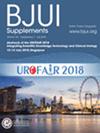Retrospective clinical and molecular characterisation of patients with penile intraepithelial neoplasia
IF 3.7
2区 医学
Q1 UROLOGY & NEPHROLOGY
引用次数: 0
Abstract
ObjectivesTo provide the first comprehensive molecular characterisation of penile intraepithelial neoplasia (PeIN) and to define the molecular alterations and clinical parameters associated with recurrence in order to enhance our ability to manage this disease.Patients and MethodsWe conducted a retrospective audit of records and an analysis of archived formalin‐fixed paraffin‐embedded (FFPE) tissue from a single‐centre population‐based consecutive sample, to characterise the genetic landscape of 28 PeIN patients through DNA copy number analysis, RNA expression analysis, and gene set enrichment analysis (GSEA). The primary and secondary study outcomes were alterations in the genetic landscape of recurring vs non‐recurring PeIN and clinical risk factors for recurrence.ResultsIn patients with PeIN recurrence, we identified seven significantly overexpressed genes (e.g.,阴茎上皮内瘤变患者的回顾性临床和分子特征
目的提供阴茎上皮内瘤变(PeIN)的第一个全面的分子特征,并确定与复发相关的分子改变和临床参数,以提高我们管理这种疾病的能力。患者和方法我们对记录进行了回顾性审核,并对来自单中心群体的连续样本存档的福尔马林固定石蜡包埋(FFPE)组织进行了分析,通过DNA拷贝数分析、RNA表达分析和基因集富集分析(GSEA)来表征28例PeIN患者的遗传景观。主要和次要研究结果是复发性与非复发性PeIN的遗传格局的改变以及复发的临床危险因素。结果在PeIN复发患者中,我们发现了7个显著过表达的基因(如MYC、SCN8A和PSTK)。重要的是,在DNA分析中,MYC位点被扩增(8q24.12‐8q24.22增益),RNA分析显示MYC过表达,与没有PeIN复发的患者相比,MYC通路(GSEA)丰富。该研究的局限性包括治疗异质性和FFPE标本对RNA质量的挑战。结论在PeIN复发患者中鉴定出7个过表达基因。其中一些转录本先前被报道与浸润性阴茎癌有关。这些发现提供了分子证据,表明pin是一种与浸润性阴茎癌相关的前驱病变,并可能为pin和低风险阴茎癌提供新的局部治疗策略。
本文章由计算机程序翻译,如有差异,请以英文原文为准。
求助全文
约1分钟内获得全文
求助全文
来源期刊

BJU International
医学-泌尿学与肾脏学
CiteScore
9.10
自引率
4.40%
发文量
262
审稿时长
1 months
期刊介绍:
BJUI is one of the most highly respected medical journals in the world, with a truly international range of published papers and appeal. Every issue gives invaluable practical information in the form of original articles, reviews, comments, surgical education articles, and translational science articles in the field of urology. BJUI employs topical sections, and is in full colour, making it easier to browse or search for something specific.
 求助内容:
求助内容: 应助结果提醒方式:
应助结果提醒方式:


